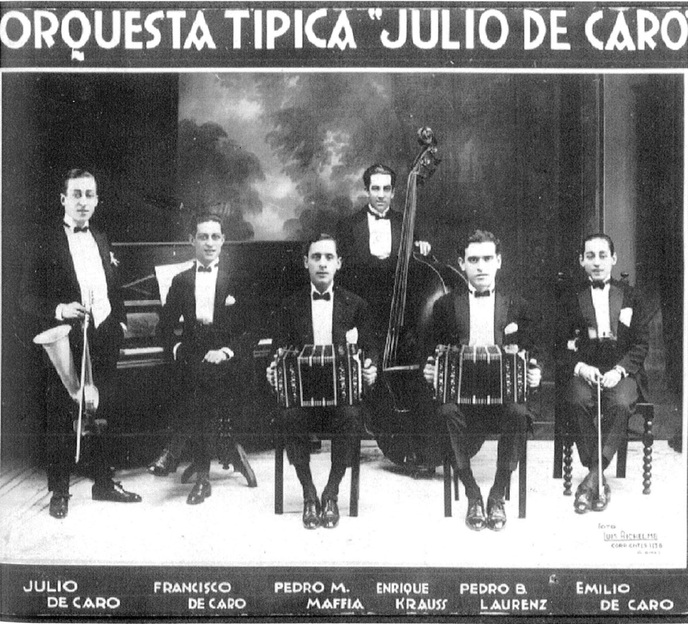The Rich History of Tango Orchestras
Hey ,
Join us as we uncover the rich tapestry of rhythms and melodies that have enchanted audiences for generations, and discover the allure of tango orchestras and their history.
Tango music has enchanted audiences around the globe for decades. At the heart of this mesmerising genre lies the Tango orchestra, a dynamic ensemble that skillfully weaves together the intricate layers of sound, emotion, and storytelling.
The rich and complex tango music we dance to now is the result of many different cultures meeting and blending in Argentina, in the late nineteenth and early twentieth centuries. Tango’s beginnings were profoundly influenced by the diverse rhythms of African dance music, and by the pre-existing dance forms of Milonga and Candombe from neighbouring Uruguay. The earliest recorded tango musicians, in the 1870s, were Afro-Argentinians. European immigrants to Argentina and Buenos Aires, a major port city, brought with them instruments such as the bandoneon, gradually leading to the formation of the classic tango sextet: a piano, a double bass, two violins, and two bandoneons. Otherwise known as a tango orquesta.
There have been countless tango composers and musicians over the years, but as you begin your tango journey you will generally start by encountering three or four key players in the history of tango music.
Perhaps the most famous composer and orquesta leader of all time is Carlos di Sarli, with his characteristic and charismatic dark glasses. Di Sarli’s music has everything and something for everyone; lyrical phrasing that will sweep you along with it, infinitely complex rhythmicity, and haunting melodies you’ll find yourself replaying in your head, long after you’ve left the milonga. Both beginners and more advanced dancers love dancing to Di Sarli, because his compas, or beat, is clear and distinctive, making it easy to follow, but the many layers of his music also offer playful opportunities for experienced tango dancers, too.
Distinct from Di Sarli’s lush lyricism or often more leisurely pace is the music of Juan D’Arienzo, famously known as ‘El Rey del Compas’, or ‘the king of the beat’. D’Arienzo’s music is renowned for its extraordinary precision, and dancers love him for the playful and delicate ways his music can be interpreted, full of small fast steps and lively decorations. D’Arienzo believed that the three keys to tango are beat, impact, and nuance, tempering the compulsion of the beat with a subtlety that encourages improvisation.
Rich and symphonic, Anibal Troilo is the third of the ‘big four’ composers, recognised to this day in Argentina as ‘The Supreme Bandoneon of Buenos Aires’, and celebrated every year on his birthday, the 11th of July. As such, Troilo’s music is characterised by extensive use of the bandoneon, an instrument that has the capacity to generate tango’s deep and powerful rhythms, complex cadences, and drawn-out lyrical sighs.
The most obviously dramatic tango composer is Osvaldo Pugliese, whose striking and immediately identifiable style of music often brings out more figurative or bold dancing, drawing out new expressions later in the evening at the milonga. Part of a slightly later generation of tango musicians, Pugliese actually observed people dance – including to his music – in the milongas of Buenos Aires, so often wrote specifically with dancers in mind. At the same time, the bold strokes of his compositions effectively bridge the gap between music for social tango and concert-style tango music.
These four musicians formed a key part of the Golden Age of Tango, which stretched from 1935 to 1955, and saw huge expansions and innovations in tango composition, orchestration, and forms of dance itself. From 1955 onwards, composers such as Astor Piazzolla revolutionised tango once again with the more modern movement of tango nuevo. In the years since Piazzolla, tango musicians have continued to experiment with the boundaries of tango, in groups such as the electronic Otros Aires, or expressive Sexteto Milonguero. Of course, Di Sarli, D’Arienzo, Troilo, and Pugliese are just four influential individuals within an ever-evolving culture of tango music, and there are many more names you might already be familiar with, or about to dance to at your next milonga: Canaro, Fresedo, Piazzola, Borgetti, De Angelis, Demare. It’s all yours to discover.
We have the Playlists organised in our website for you to listen to and discover Tango Music categorised by the Orchestra. They are available as both Spotify and YouTube Playlists. You can check them out here:
Happy listening, and happy dancing!
If you have any questions please reply to this email or let us know when suits you for a quick chat about all things tango. We’re here to support you on your dancing journey!
Warm regards,
Winston, Silvia, and everyone at Tango Amistoso


Leave a Reply